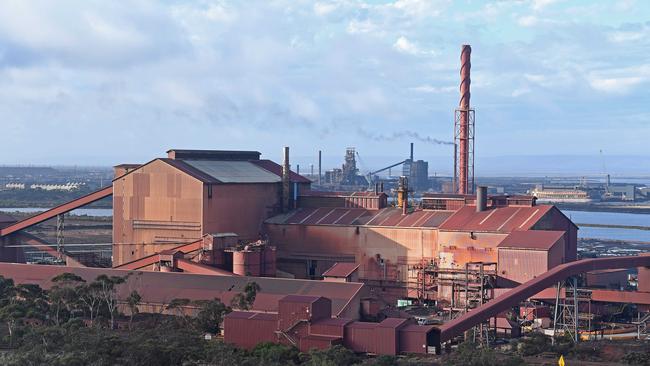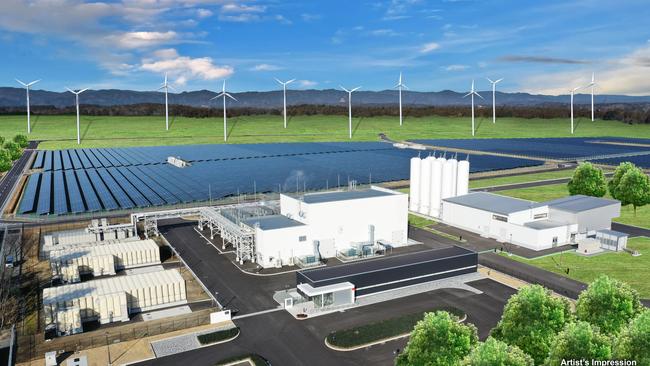Economic potential of hydrogen could make SA ‘superpower’ of the world, says Premier
Hydrogen puts SA on the precipice of an economic boom similar to what the gold rush meant for Victoria, the Premier says – and would make the state a “superpower”.
Business
Don't miss out on the headlines from Business. Followed categories will be added to My News.
The economic potential of hydrogen is “profound’’ and could position South Australia at the centre of “a superpower effort to decarbonise the world’’, Premier Peter Malinauskas told a major investment conference in Adelaide on Friday.
Mr Malinauskas said his vision was that hydrogen would be to SA what gold was to Victoria during the gold rush, or iron ore has been to Western Australia more recently, driving billions in investment and underpinning a high-prosperity, highly-skilled economy.
Speaking at the Committee for Adelaide’s South Australia Investment Conference on Friday, Mr Malinauskas said there was “substantial global interest’’ in the work being done in the hydrogen sphere in SA, with the government’s $593m hydrogen production facility and power plant, to be built at Whyalla, a central component of the planned shift to a green power economy.
Mr Malinauskas said the facility – a promise in the lead up to this year’s state election – was scheduled to be built by the start of 2026, and international firms such as Mitsubishi Heavy Industries were involved in the process.
“This is a big undertaking, but already there’s been substantial global interest,’’ Mr Malinauskas said.

“There’s been a market sounding process and we (will) go into a more formal process which I will have something to say about in the coming weeks to actually procure that facility.
“It will capture the world’s attention because no one has done this before.’’
Mr Malinauskas said he was “not sitting around’’ waiting for someone else to make a financial decision to go ahead with such a project.
“We are doing this, But we are very, very keen to do this as a government in conjunction with the private sector and the amount of interest that we received already up to this point, to participate and add more relevance to the project is actually nothing short of exceptionally exciting.’’
Mr Malinauskas said there was the opportunity, “particularly in the Upper Spencer Gulf, of our state, and its surrounds, to be a centre for the hydrogen industry globally’’.
“And the benefit of that to our people could be absolutely profound.’’

The state government is planning to build what would be the world’s largest electrolyser, which converts water to hydrogen and oxygen, as well as a 200MW power station and a large-scale power storage facility.
Converting renewable energy such as solar and wind to hydrogen would enable it to be stored for later use as energy, and it could also be used in industrial processes such as steelmaking.
Mr Malinauskas said committing to building the hydrogen facility at Whyalla was a demonstration of the government’s “ambition’’ and willingness to ‘go out there on the risk curve’’, like former premier Jay Weatherill did before him in building what was at the time the world’ largest grid-scale battery following the 2016 statewide blackout.
Mr Malinauskas said there was a national race on to be the leader in hydrogen, “and our government’s policy is that by the end of 2026, we are back in front of that race, capturing the world’s attention’’.
“If South Australia is able to position itself as a centre of the hydrogen effort, the economic opportunity is profound even on a conservative analysis,’’ he said.
“On a more ambitious one, it could literally be seeing South Australia be the centre of a superpower effort to decarbonise the world … for our benefit.’’
Mr Malinauskas said Victoria had gold in the 1800s “and made a great economy out of it’’.
New South Wales and Queensland has coal in the 20th century, while Western Australia in the 21st century has iron ore and gas.
“The second half of the 21st century can be South Australia and hydrogen.’’
Hydrogen will bring steelmaking back home, says Garnaut
The shift to a low carbon economy will bring steelmaking back to Australia, Professor Ross Garnaut says, with basic economics dictating that it will be cheaper to process iron ore here using renewable energy and hydrogen.
Speaking at the Committee for Adelaide’s South Australia Investment Conference, Prof Garnaut said the nation was lucky in that it had a number of key advantages as the world moves towards net zero, with our abundance of critical minerals and our vast renewable energy resources at the forefront.
Prof Garnaut said the new low-cost method of steel production in a low carbon world would be hydrogen based, and with the export of hydrogen in a liquefied state expensive, this meant it made sense to process Australian iron ore at home.
“The low cost way on current knowledge of turning iron ore into iron metal will be through reduction using hydrogen,’’ he said.
“In the zero emissions world that’s using hydrogen made from renewable energy … and that will be most economically done in Australia.
“The differences between costs here and in other countries are huge.’’
More Coverage
Originally published as Economic potential of hydrogen could make SA ‘superpower’ of the world, says Premier




